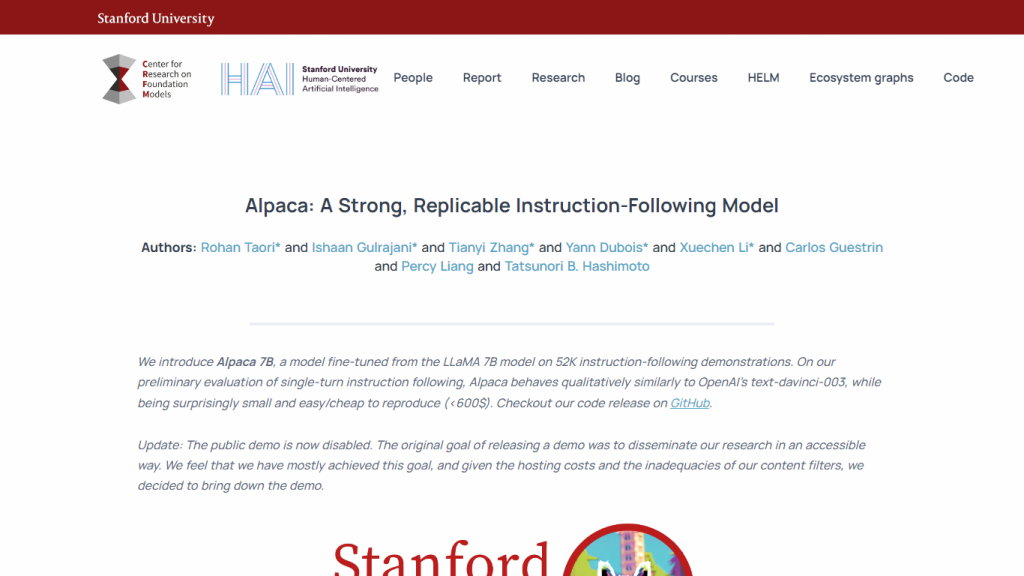What is Alpaca?
Alpaca is a new AI model developed by Stanford’s Center for Research on Foundation Models and is low-cost and academically focused. It is a fine-tuned version of Meta’s LLaMA 7B, a large instruction-following language model. It carries out the same tasks as OpenAI’s text-davinci-003 but is significantly smaller and easier to replicate, putting it more within reach for the AI research community. This model further aids the democratization initiative from Stanford in the collection of feedback and interacting with the community as they try to look further into behaviors and capabilities.
Some of the Key Features & Advantages
Cost-Effective Reproduce: Alpaca can be reproduced at less than $600; therefore, this goes a long way in making advanced AI research much accessible due to a wider audience.
Fine-Tuned from LLaMA 7B: Through the use of Meta’s LLaMA 7B model, Alpaca makes actual very excellent instruction following capabilities.
Instruction-Following Competency: Alpaca performed at a level comparable to that of OpenAI’s text-davinci-003 during preliminary evaluations. The Stanford CRFM team welcomes further community-driven feedback to continue refining and enhancing the model.
Ethical Research Forward: The model encourages research within academia in calibrating AI to human values and in the correction of model shortcomings.
Use Cases and Applications for Alpaca
It finds application from scholarship to the most varied applications in a number of industries. The features of instruction following make it quite adequate for being applied to tasks related to natural language processing, content creation, and not least—automated customer support. The focused domains for its application lie in areas such as education, healthcare, and finance. For instance, in the domain of education and learning, Alpaca will be useful for the development of educational materials and in tutoring. In the health sector, it ensures communication with the patients and the analysis of their data.
How to Use Alpaca
Using Alpaca is straightforward and handy. Here is a step-by-step process:
- Access the Platform: Visit the Alpaca platform of Stanford CRFM.
- Set Up: Proceed with all the set-up. Configure your account and the model with your requirements.
- Guidelines to Enter: Input the guidelines or the tasks that you wish Alpaca to proceed with.
- Output Check: Appraise the output that you received from Alpaca, and respond with your feedback to tell them how the responses could have been better.
It is advised to have clear instructions for the best results. Besides, it is very helpful to update the model regularly with community feedback.
How Alpaca Works
Notably, Alpaca builds on top of Meta’s LLaMA 7B model, which is supposed to be its foundational architecture. What is more, it is made using sophisticated machine learning and NLP technologies such that it can follow instructions and give outputs appropriately. The fine tuning process includes training Alpaca on diverse sets of data to make it better at following instructions. Therefore, this workflow will help Alpaca execute its tasks over a broad range of domains smoothly and with maximum accuracy.
Pros and Cons of Alpaca
Alpaca is an AI model with numerous pros and cons, as stated below:
-
Pros:
- Cheap and easy to scale
- Good performance for instructions following
- Boosts community feedback and ethical research
-
Cons:
- May have to be updated always to fix its flaws
- Performance could degrade with the complexity of tasks
The user response has been marvellous, and the ease of use and cheapness are its greatest perks.
Conclusion on Alpaca
Alpaca is a cost-effective, super-intelligent AI model that was finetuned from Meta’s LLaMA 7B. It can follow instructions and is community-driven to ensure that AI research is ethics-bound. The model has some weaknesses built right within it; however, the processing of constant updates with feedback integrations ensures that it keeps getting better. Future improvements will further widen the potential applications of the model since it is one of the promising ones to dominate in the future of AI.
FAQs for Alpaca
-
What is Alpaca?
It is an instruction-following AI model developed by Stanford’s CRFM, fine-tuned from Meta’s LLaMA 7B. -
How much for reproducing it?
More or less, the reproduction cost of Alpaca is below $600, so it is very cost-friendly for Artificial Intelligence research purposes. -
What are the key features of Alpaca?
Key features include its low-cost reproduction, fine-tuned from LLaMA 7B, a high instruction-following competence, and a community-driven feedback approach. -
Major use cases of Alpaca
Alpaca can be applied within any industry in the verticals of education, healthcare, and finance to perform tasks that involve natural language processing, content creation, and automated customer support. -
How does Alpaca work?
Alpaca works on top of the LLaMA 7B by Meta and makes use of advanced machine learning algorithms for instruction-following.










